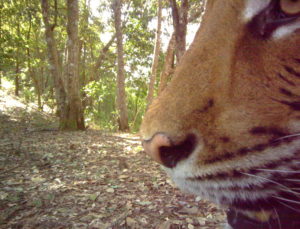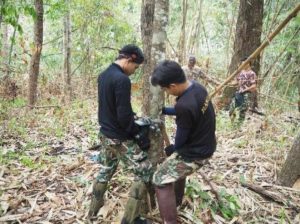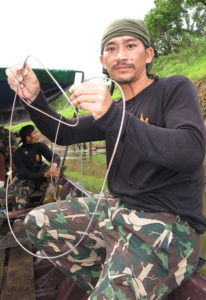The first six months of the Freeland activities in Khao Laem National Park are detailed in the recent interim report to WildCats Conservation Alliance.
Khao Laem, in the Tenasserim mountain range, is a rich and diverse landscape made up of a mosaic of bamboo forest, hill evergreen forest, dry evergreen forest, mixed deciduous and deciduous dipterocarp forest. It is one of 17 protected areas in Thailand’s Western Forest Complex and covers an area of 1,497 km2, with a central part flooded by the Vajiralongkorn dam in 2001. Its close proximity to the Thung Yai Naresuan Wildlife Sanctuary, Lam Khlong Ngu National Park and Thong Pha Phum National Park makes it a suitable habitat for a variety of wildlife including the Indochinese tiger.
Although it is known that tigers use this forest, data is lacking on the population. The National Park authority is working with Freeland to improve its ability to carry out robust monitoring by collecting baseline presence/absence data and since the start of the survey 28 camera traps were in operation for a total of 3,854 nights over a 108km2 survey area. This was carried out by 16 forest patrol officers with on-job-training from Freeland staff.
Protection measures are in place from National Park rangers who are already trained in SMART* patrol techniques, so the second objective of the project aims to support the field based data collection in addition to mentoring in enhanced data entry and interpretation which will help the long term patrol planning.
The eight patrol teams conducted 185 patrols over 663 patrol days, covering a total distance of 6,841.14 kilometres. Wildlife data reported from these patrols recorded 514 distinct locations which included 4 tiger tracks, 115 violations and 21 cases were sent to the police for prosecution. The patrols covered 1,164 km2 which accounts for 78.10% of the total park are Khao Laem National Park.
When comparing patrol data from 2018 and 2019, it can be seen that the number of patrol days, the distribution of wildlife and consequently, the threats indicated have increased. Information from Smart Patrol Monthly Meetings at Khao Laem suggests the eith patrol teams are more interested in patrolling because they have a clearer understood of what data should be collected. They also now know how to identify threats and have improved they identification of wildlife track and sign.
*Spatial Monitoring and Reporting Tool.

IndoChinese tiger © KLNP/Freeland

Camera trap training © Freeland

Snare confiscated in Khao Laem. © Freeland

